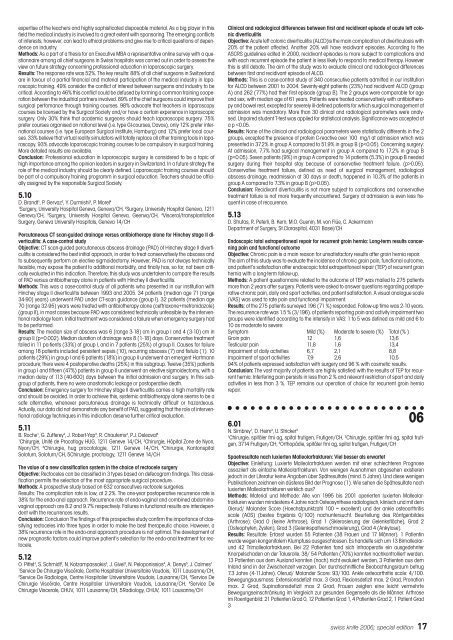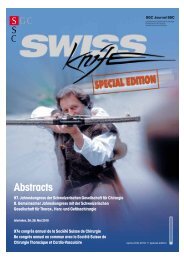Abstracts 4. Gemeinsamer Jahreskongress der ... - SWISS KNIFE
Abstracts 4. Gemeinsamer Jahreskongress der ... - SWISS KNIFE
Abstracts 4. Gemeinsamer Jahreskongress der ... - SWISS KNIFE
Create successful ePaper yourself
Turn your PDF publications into a flip-book with our unique Google optimized e-Paper software.
swissknife spezial 06 12.06.2006 13:39 Uhr Seite 17<br />
expertise of the teachers and highly sophisticated disposable material. As a big player in this<br />
field the medical industry is involved to a great extent with sponsoring. The emerging conflicts<br />
of interests, however, can lead to ethical problems and give rise to critical questions of dependence<br />
on industry.<br />
Methods: As a part of a thesis for an Executive MBA a representative online survey with a questionnaire<br />
among all chief surgeons in Swiss hospitals was carried out in or<strong>der</strong> to assess the<br />
view on future strategy concerning professional education in laparoscopic surgery.<br />
Results: The response rate was 52%. The key results: 88% of all chief surgeons in Switzerland<br />
are in favour of a partial financial and material participation of the medical industry in laparoscopic<br />
training. 49% consi<strong>der</strong> the conflict of interest between surgeons and industry to be<br />
critical. According to 46% this conflict could be defused by forming a common training cooperation<br />
between the industrial partners involved. 89% of the chief surgeons could improve their<br />
surgical perfomance through training courses. 98% advocate that teachers in laparoscopy<br />
courses be licensed by the Surgical Society and/or have a certain experience in laproscopic<br />
surgery. Only 30% think that academic surgeons should teach laparoscopic surgery. 75%<br />
prefer courses organised on national level (i.e. type GI-courses, Davos), only 12% prefer international<br />
courses (i.e. type European Surgical Institute, Hamburg) and 12% prefer local courses.<br />
33% believe that virtual reality simulators will totally replace all other training tools in laparascopy.<br />
93% advocate laparoscopic training courses to be compulsory in surgical training.<br />
More detailed results are available.<br />
Conclusion: Professional education in laparoscopic surgery is consi<strong>der</strong>ed to be a topic of<br />
high importance among the opinion lea<strong>der</strong>s in surgery in Switzerland. In a future strategy the<br />
role of the medical industry should be clearly defined. Laparoscopic training courses should<br />
be part of a compulsory training programm in surgical education. Teachers should be officially<br />
assigned by the responsible Surgical Society.<br />
5.10<br />
D. Brandt 1 , P. Gervaz 2 , Y. Durmishi 3 , P. Morel 4<br />
1 Surgery, University Hospital Geneva, Geneva/CH, 2 Surgery, University Hospital Geneva, 1211<br />
Geneva/CH, 3 Surgery, University Hospital Geneva, Geenva/CH, 4 Visceral/transplantation<br />
Surgery, Geneva University Hospitals, Geneva 14/CH<br />
Percutaneous CT scan-guided drainage versus antibiotherapy alone for Hinchey stage II diverticulitis:<br />
A case-control study<br />
Objective: CT scan-guided percutaneous abscess drainage (PAD) of Hinchey stage II diverticulitis<br />
is consi<strong>der</strong>ed the best initial approach, in or<strong>der</strong> to treat conservatively the abscess and<br />
to subsequently perform an elective sigmoidectomy. However, PAD is not always technically<br />
feasible, may expose the patient to additional morbidity, and finally has, so far, not been critically<br />
evaluated in this indication. Therefore, this study was un<strong>der</strong>taken to compare the results<br />
of PAD versus antibiotherapy alone in patients with Hinchey II diverticulitis.<br />
Methods: This was a case-control study of all patients who presented in our institution with<br />
Hinchey stage II diverticulitis between 1993 and 2005. 34 patients (median age 71 [range<br />
34-90] years) un<strong>der</strong>went PAD un<strong>der</strong> CT-scan guidance (group I). 32 patients (median age<br />
70 [range 32-95] years were treated with antibiotherapy alone (ceftriaxone+metronidazole)<br />
(group II), in most cases because PAD was consi<strong>der</strong>ed technically unfeasible by the interventional<br />
radiology team. Initial treatment was consi<strong>der</strong>ed a failure when emergency surgery had<br />
to be performed.<br />
Results: The median size of abscess was 6 [range 3-18] cm in group I and 4 [3-10] cm in<br />
group II (p=0.002). Median duration of drainage was 8 [1-18] days. Conservative treatment<br />
failed in 11 pa-tients (33%) of group I, and in 7 patients (25%) of group II. Causes for failure<br />
among 18 patients included persistent sepsis (10), recurring abscess (7) and fistula (1). 10<br />
patients (29%) in group I and 6 patients (18%) in group II un<strong>der</strong>went an emergent Hartmann<br />
procedure; there were 4 postoperative deaths (25%) in this subgroup. Twelve (35%) patients<br />
in group I and fifteen (47%) patients in group II un<strong>der</strong>went an elective sigmoidectomy, with a<br />
median delay of 113 [40-600] days between the initial admission and surgery. In this subgroup<br />
of patients, there no were anastomotic leakage or postoperative death.<br />
Conclusion: Emergency surgery for Hinchey stage II diverticulitis carries a high mortality rate<br />
and should be avoided. In or<strong>der</strong> to achieve this, systemic antibiotherapy alone seems to be a<br />
safe alternative, whenever percutaneous drainage is technically difficult or hazardeous.<br />
Actually, our data did not demonstrate any benefit of PAD, suggesting that the role of interventional<br />
radiology techniques in this indication deserve further critical evaluation.<br />
5.11<br />
B. Roche 1 , G. Zufferey 2 , J. Robert-Yap 3 , R. Chautems 4 , P.J. Deleaval 5<br />
1 Chirurgie, Unité de Procotlogy HUG, 1211 Geneve 14/CH, 2 Chirurgie, Hôpital Zone de Nyon,<br />
Nyon/CH, 3 Chirurgie, hug procotologie, 1211 Geneve 14/CH, 4 Chirurgie, Kantonspital<br />
Soloturn, Soloturn/CH, 5Chirurgie, proctology, 1211 Geneve 14/CH<br />
The value of a new classification system in the choice of rectocele surgery<br />
Objective: Rectoceles can be classified in 3 types based on defecogram findings. This classification<br />
permits the selection of the most appropriate surgical procedure.<br />
Methods: A prospective study based on 632 consecutives rectocele surgeries.<br />
Results: The complication rate is low, at 2.2%. The one-year postoperative recurrence rate is<br />
38% for the endo-anal approach. Recurrence rate of endo-vaginal and combined abdominovaginal<br />
approach are 8.2 and 9.7% respectively. Failures in functional results are interdependent<br />
with the recurrences results.<br />
Conclusion: Conclusion The findings of this prospective study confirm the importance of classifying<br />
rectoceles into three types in or<strong>der</strong> to make the best therapeutic choice. However, a<br />
38% recurrence rate in the endo-anal approach procedure is not optimal. The development of<br />
new prognostic factors could improve patient’s selection for the endo-anal treatment for rectocele.<br />
5.12<br />
O. Pittet 1 , S. Schmidt 2 , N. Kotzampassakis 3 , J. Givel 3 , N. Peloponissios 4 , A. Denys 5 , J. Calmes 1<br />
1 Service De Chirurgie Viscérale, Centre Hospitalier Universitaire Vaudois, 1011 Lausanne/CH,<br />
2 Service De Radiologie, Centre Hospitalier Universitaire Vaudois, Lausanne/CH, 3 Service De<br />
Chirurgie Viscérale, Centre Hospitalier Universitaire Vaudois, Lausanne/CH, 4 Service De<br />
Chirurgie Viscerale, CHUV, 1011 Lausanne/CH, 5Radiology, CHUV, 1011 Lausanne/CH<br />
Clinical and radiological differences between first and recidivant episode of acute left colonic<br />
diverticulitis<br />
Objective: Acute left colonic diverticulitis (ALCD)is the main complication of diverticulosis with<br />
20% of the patient affected. Another 20% will have recidivant episodes. According to the<br />
ASCRS guidelines edited in 2000, recidivant episodes is more subject to complications and<br />
with each recurrent episode the patient is less likely to respond to medical therapy. However<br />
this is still debate. The aim of the study was to evaluate clinical and radiological differences<br />
between first and recidivant episode of ALCD.<br />
Methods: This is a case-control study of 340 consecutive patients admitted in our institution<br />
for ALCD between 2001 to 200<strong>4.</strong> Seventy-eight patients (23%) had recidivant ALCD (group<br />
A) and 262 (77%) had their first episode (group B). The 2 groups were comparable for age<br />
and sex, with median age of 61 years. Patients were treated conservatively with antibiotherapy<br />
and bowel rest, excepted for severely ill-defined patients for which surgical management at<br />
admission was mandatory. More than 30 clinical and radiological parameters were analysed.<br />
Unpaired student T-test was applied for statistical analysis. Significance was accepted at<br />
a p
















